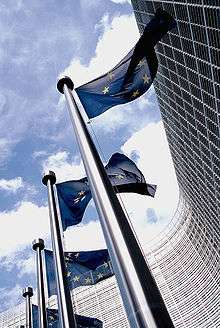Directorate-General for the Environment
| European Union |
 This article is part of a series on the |
Policies and issues
|
The Directorate-General for the Environment (DG Environment) is a Directorate-General of the European Commission, responsible for the European Union policy area of the environment.
In February 2010, departments relating to climate change were split off from the environment, industry and external relations DGs to form the DG Climate Action.[1]
Mission
The DG's main role is to initiate and define new environmental legislation and to ensure that measures, which have been agreed, are actually put into practice in the member states of the European Union. The overall mission statement for 2005 is: "Protecting, preserving and improving the environment for present and future generations, and promoting sustainable development". The mission statement is divided into the following sub-statements:[2]
- To maintain and improve the quality of life through a high level of protection of our natural resources, effective risk assessment and management and the timely implementation of Community legislation.
- To foster resource-efficiency in production, consumption and waste-disposal measures.
- To integrate environmental concerns into other EU policy areas.
- To promote growth in the EU that takes account of the economic, social and environmental needs both of our citizens and of future generations.
- To address the global challenges facing us notably combating climate change and the international conservation of biodiversity.
- To ensure that all policies and measures in the above areas are based on a multi-sectoral approach, involve all stakeholders in the process and are communicated in an effective way.
Structure
The Environment DG is based largely in Brussels with the unit dealing with radiation protection based in Luxembourg.
The Directorate-General is organised into an Office of the Director-General and 7 directorates:
- Directorate A: Legal Affairs & Cohesion
- Directorate B: Nature
- Directorate C: Industry
- Directorate D: Water, Chemicals & Biotechnology
- Directorate E: International affairs
- Directorate F: Strategy
- Shared Resources Directorate (SRD) (shared with DG Climate Action)
History
EU environmental policy started as a collection of disparate laws which had no specific Treaty basis.[3] There was no department dedicated to environmental issues for the first 15 years of the European Commission’s existence. It was only in 1973 that an environmental unit was created within DG Industry; a fully-fledged Environment Directorate-General (DG) was then set up in 1981.[4] However, it remained a relatively weak DG in the Commissioner for several years due to its lack of institutional experience and human resources;[5] Having started with 5 officials in 1973, there were still only about 60 officials in the 1980s.[4]
In its early years, DG Environment hired specialists with technical knowledge who had a different culture to the other Commission’s officials. This ‘gave [it] a reputation for being dominated by […] “ecological freaks”'.[6] However, overtime DG environment matured and settled into the Commission’s ways of working. In particular this meant taking politics more into consideration when formulating legislation so that it could be adopted and better implemented.[7]
The Fifth Environmental Action Programme[8] which came into force on 1 January 1993 marked a sea-change in DG environment’s approach to policy-making. It attempted to present the DG and its policies in a more contemporary and constructive light. The programme demonstrated that legislation was no longer to be made solely behind closed doors, but together with all social and economic partners.[9]
Resources
The Directorate-General for Environment has a staff of about 650 civil servants.
- Commissioner: Karmenu Vella
- Director General: Daniel Calleja Crespo
Past commissioners:
- Stavros Dimas, 2004-2009
- Margot Wallström, 1999–2004
See also
- Aarhus Convention
- Directorate-General for Climate Action
- Directorate-General for Maritime Affairs and Fisheries
- Directorate-General of the Joint Research Centre (DG JRC)
- European Environment Agency
- EU environmental policy
References
- ↑ "Commission creates two new Directorates-General for Energy and Climate Action". European Commission. 17 February 2010. Retrieved 12 December 2014.
- ↑ "Environment DG Information Brochure" (PDF). European Commission.
- ↑ Knill, C. and Liefferink, D (2007) Environmental politics in the European Union. Manchester University Press, Manchester.
- 1 2 Schön-Quinlivan (2012) The European Commission, In: Jordan, A.J. and Adelle, C. (eds) Environmental Policy in the European Union: Contexts, Actors and Policy Dynamics (3e). Earthscan: London and Sterling, VA.
- ↑ Cini, M. (1997) ‘Administrative culture in the European Commission: The cases of competition and environment’ in N. Nugent (ed) At the Heart of the Union: Studies of the European Commission, St Martin’s Press, New York
- ↑ Cini, M. (1997) ‘Administrative culture in the European Commission: The cases of competition and environment’ in N. Nugent (ed) At the Heart of the Union: Studies of the European Commission, St Martin’s Press, New York. p78
- ↑ Weale, A. and Williams, A. (1993) ‘Between economy and ecology? The single market and the integration of environmental policy’, in D. Judge (ed) A Green Dimension for the European Community: Political Issues and Processes, Frank Cass, Portland.
- ↑ (OJ, 1993, C138/26)
- ↑ Tanasescu, I. (2012) In: Jordan, A.J. and Adelle, C. (eds) Environmental Policy in the European Union: Contexts, Actors and Policy Dynamics (3e). Earthscan: London and Sterling, VA.


